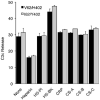Heparan sulfate, including that in Bruch's membrane, inhibits the complement alternative pathway: implications for age-related macular degeneration
- PMID: 20876352
- PMCID: PMC3639479
- DOI: 10.4049/jimmunol.0903596
Heparan sulfate, including that in Bruch's membrane, inhibits the complement alternative pathway: implications for age-related macular degeneration
Abstract
An imbalance between activation and inhibition of the complement system has been implicated in the etiologies of numerous common diseases. Allotypic variants of a key complement fluid-phase regulatory protein, complement factor H (CFH), are strongly associated with age-related macular degeneration (AMD), a leading cause of worldwide visual dysfunction, although its specific role in AMD pathogenesis is still not clear. CFH was isolated from individuals carrying combinations of two of the nonsynonymous coding variants most strongly associated with AMD risk, V62/H402 (risk haplotype variants), I62/Y402 (nonrisk haplotype variants), and V62/Y402. These proteins were used in two functional assays (cell surface- and fluid-phase-based) measuring cofactor activity of CFH in the factor I-mediated cleavage of C3b. Although no variant-specific differences in the cofactor activity were detected, when heparan sulfate (HS) was added to these assays, it accelerated the rate of C3b cleavage, and this effect could be modulated by degree of HS sulfation. Bruch's membrane/choroid, a site of tissue damage in AMD, contains high concentrations of glycosaminoglycans, including HS. Addition of human Bruch's membrane/choroid to the fluid-phase assay accelerated the C3b cleavage, and this effect was lost posttreatment of the tissue with heparinase III. Binding of CFH variants to Bruch's membrane/choroid isolated from elderly, non-AMD donor eyes, was similar, as was the functional activity of bound CFH. These findings refine our understanding of interactions of HS and complement and support the hypothesis that these interactions play a role in the transition between normal aging and AMD in Bruch's membrane/choroid.
Figures







Similar articles
-
Identification of factor H-like protein 1 as the predominant complement regulator in Bruch's membrane: implications for age-related macular degeneration.J Immunol. 2014 Nov 15;193(10):4962-70. doi: 10.4049/jimmunol.1401613. Epub 2014 Oct 10. J Immunol. 2014. PMID: 25305316 Free PMC article.
-
Age-dependent changes in heparan sulfate in human Bruch's membrane: implications for age-related macular degeneration.Invest Ophthalmol Vis Sci. 2014 Jul 29;55(8):5370-9. doi: 10.1167/iovs.14-14126. Invest Ophthalmol Vis Sci. 2014. PMID: 25074778
-
Impaired binding of the age-related macular degeneration-associated complement factor H 402H allotype to Bruch's membrane in human retina.J Biol Chem. 2010 Sep 24;285(39):30192-202. doi: 10.1074/jbc.M110.103986. Epub 2010 Jul 26. J Biol Chem. 2010. PMID: 20660596 Free PMC article.
-
Age-related macular degeneration and the role of the complement system.Mol Immunol. 2015 Sep;67(1):43-50. doi: 10.1016/j.molimm.2015.02.032. Epub 2015 Mar 21. Mol Immunol. 2015. PMID: 25804937 Review.
-
The role of complement in age-related macular degeneration: heparan sulphate, a ZIP code for complement factor H?J Innate Immun. 2014;6(4):407-16. doi: 10.1159/000356513. Epub 2013 Dec 7. J Innate Immun. 2014. PMID: 24335201 Free PMC article. Review.
Cited by
-
Targeting Lipid Metabolism for the Treatment of Age-Related Macular Degeneration: Insights from Preclinical Mouse Models.J Ocul Pharmacol Ther. 2022 Jan-Feb;38(1):3-32. doi: 10.1089/jop.2021.0067. Epub 2021 Nov 17. J Ocul Pharmacol Ther. 2022. PMID: 34788573 Free PMC article. Review.
-
Age-Related Macular Degeneration: A Disease of Systemic or Local Complement Dysregulation?J Clin Med. 2014 Nov 3;3(4):1234-57. doi: 10.3390/jcm3041234. J Clin Med. 2014. PMID: 26237601 Free PMC article. Review.
-
Local factor H production by human choroidal endothelial cells mitigates complement deposition: implications for macular degeneration.J Pathol. 2022 May;257(1):29-38. doi: 10.1002/path.5867. Epub 2022 Feb 17. J Pathol. 2022. PMID: 35038170 Free PMC article.
-
Decreased membrane complement regulators in the retinal pigmented epithelium contributes to age-related macular degeneration.J Pathol. 2013 Apr;229(5):729-42. doi: 10.1002/path.4128. Epub 2013 Jan 24. J Pathol. 2013. PMID: 23097248 Free PMC article.
-
Human complement factor H Y402H polymorphism causes an age-related macular degeneration phenotype and lipoprotein dysregulation in mice.Proc Natl Acad Sci U S A. 2019 Feb 26;116(9):3703-3711. doi: 10.1073/pnas.1814014116. Epub 2019 Feb 11. Proc Natl Acad Sci U S A. 2019. PMID: 30808757 Free PMC article.
References
-
- Rodriguez de Cordoba S, Esparza-Gordillo J, Goicoechea de Jorge E, Lopez-Trascasa M, Sanchez-Corral P. The human complement factor H: functional roles, genetic variations and disease associations. Molecular immunology. 2004;41:355–367. - PubMed
-
- DiScipio RG. Ultrastructures and interactions of complement factors H and I. J Immunol. 1992;149:2592–2599. - PubMed
Publication types
MeSH terms
Substances
Grants and funding
LinkOut - more resources
Full Text Sources
Other Literature Sources
Medical
Miscellaneous

